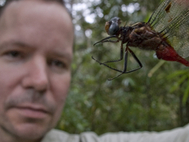
Damselflies in New Guinea and the Bismarck Archipelago
Damselflies (Odonata, Zygoptera) of the Southeast Asian and Indo-Pacific tropics have been studied with regard to their distributional history during the past years. Special focus is currently laid by the author on the rich odonate fauna of New Guinea, which combines Oriental and Australian elements and at the same time harbors a considerable number of endemic radiations. The feather-legged damselflies (Platycnemididae) are speciose in the region and provide suitable subjects for historical biogeographical studies. The subfamily Calicnemiinae is absent from the Wallacea, i.e. from Sulawesi, the Moluccas and the Lesser Sunda Islands but highly diverse in the Himalayas and across mainland SE Asia and Sundaland as well as in the Philippines and in New Guinea. The phylogenetic reconstruction of the Calicnemiinae allows for the postulation of biogeographical pathways from SE Asia to New Guinea via former island arc systems in the Late Cretaceous to mid-Eocene. The central terranes of New Guinea, which have a complex history related to oceanic and continental rifting, probably served as the center of origin for the Papuan Platycnemididae as well as for the Philippine and Solomon genera which may be assumed to have secondarily reached the Philippines and Solomons via the South-Caroline-Melanesian Arc system in the Oligocene or Miocene. Recent odonatological survey work in New Guinea and the Bismarck
Archipelago provides new records of, among others, species in the families Lestidae, Protoneuridae, Rhinocyphidae, which indicate a common biogeographical history of dragon-and damselflies from the (former) Tertiary island arcs to the north (South Caroline Arc) and to the east (Melanesian Arcs) of the island. The odonate fauna of New Britain island (Papua New Guinea), which recently has been the subject of a Rapid Biodiversity Assessment, will be discussed in more detail.






